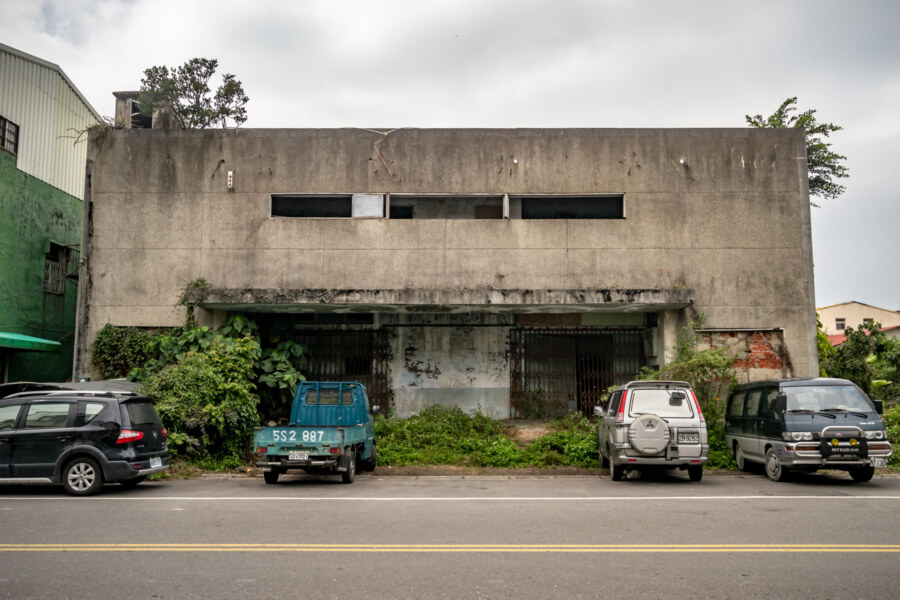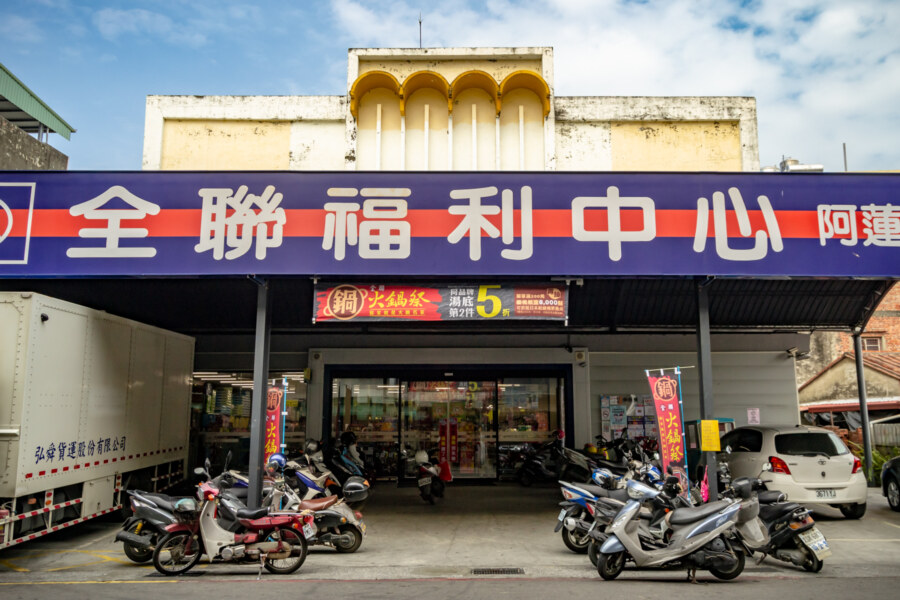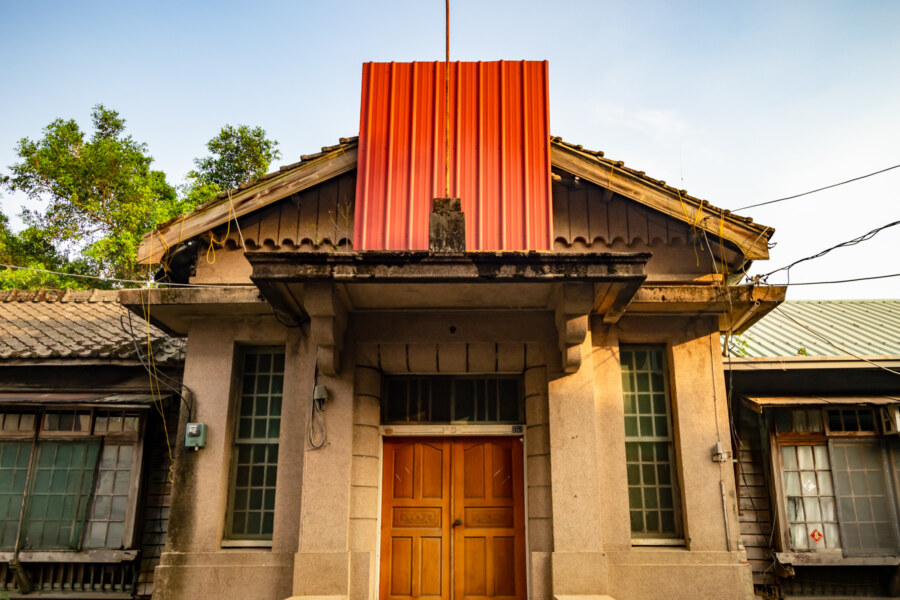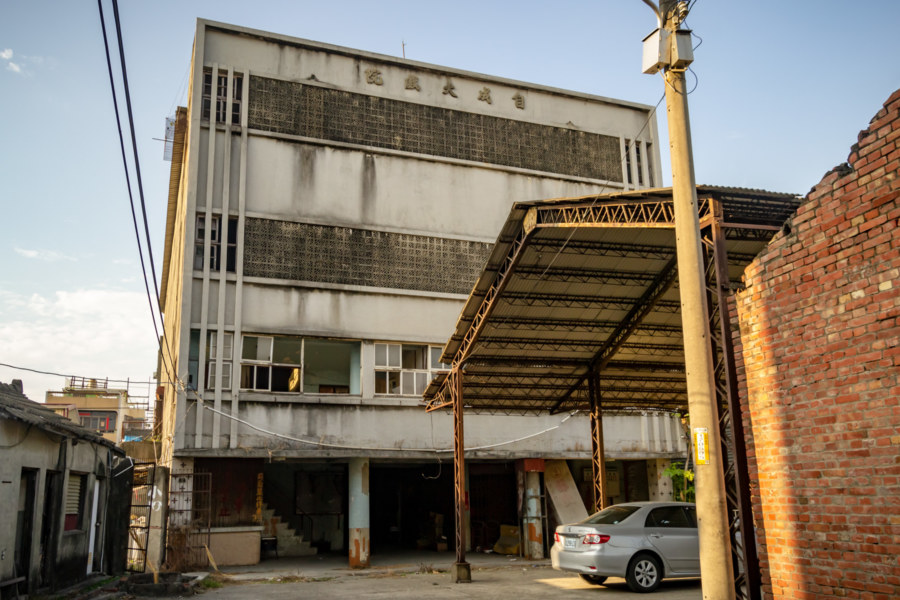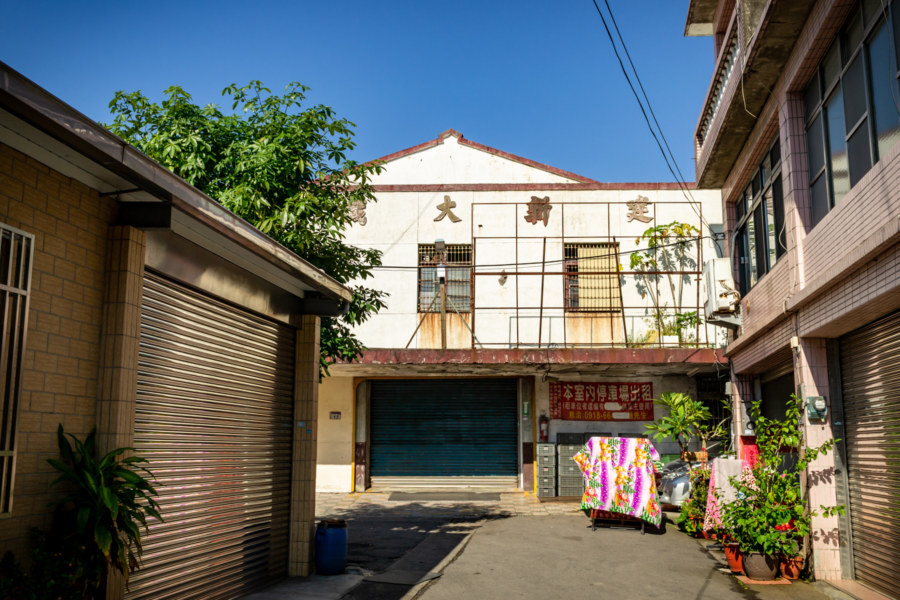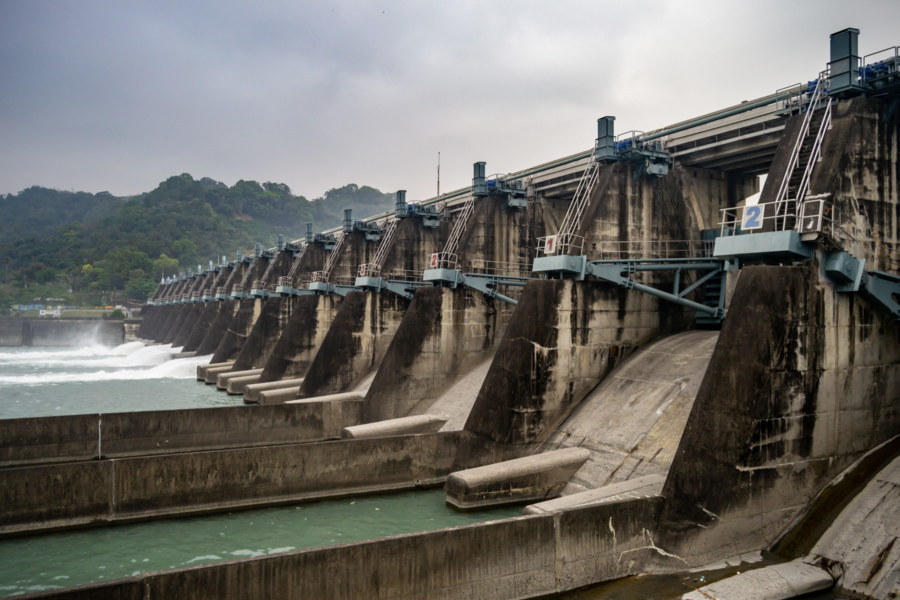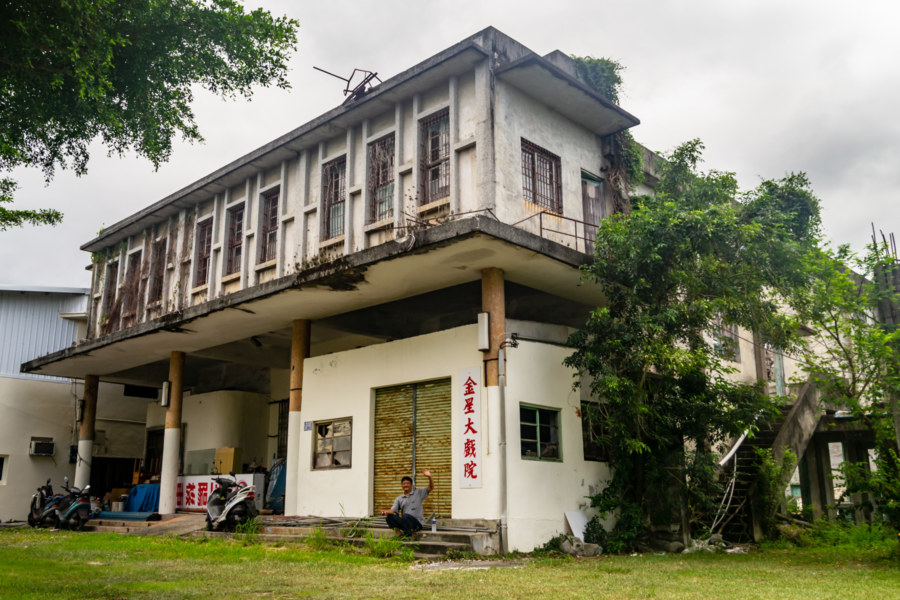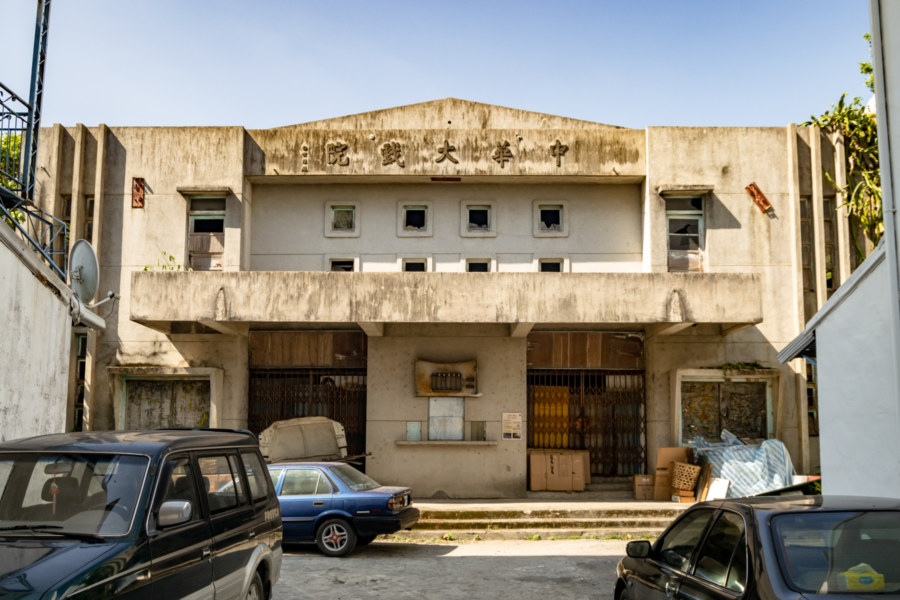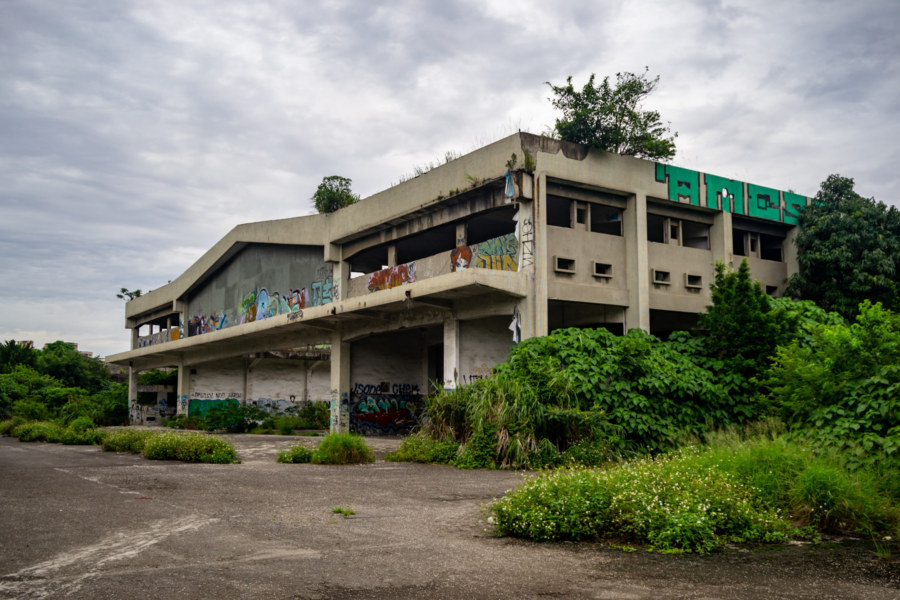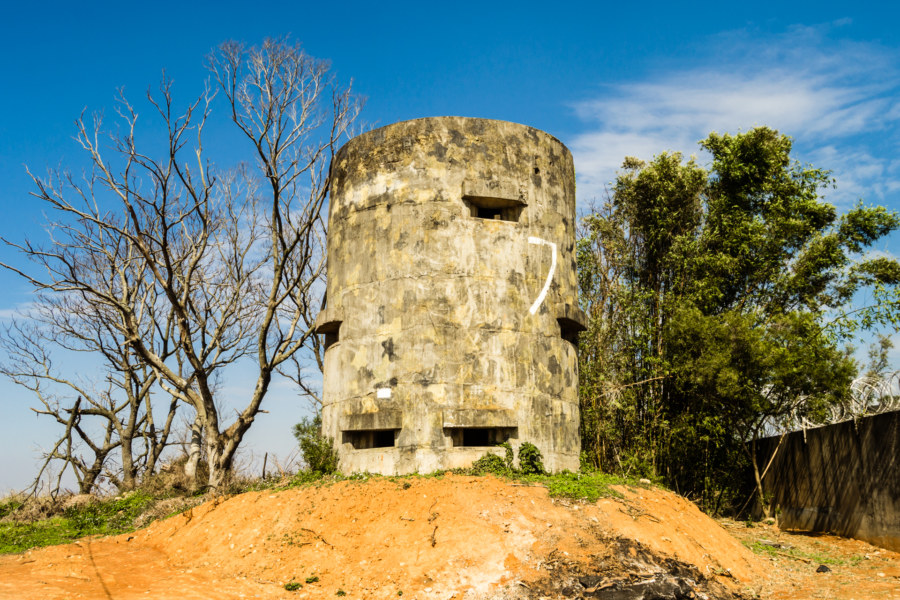Huázhōu Theater (華洲戲院) is a long-abandoned cinema located in Nanxi, a rural district nestled in the low hills of eastern Tainan, Taiwan. Easily reached via Provincial Highway 3, the main settlement in Nanxi is situated along the middle reaches of Tsengwen River, the fourth longest in the country. Nanxi, like most other parts of rural Taiwan, has suffered an almost continuous population outflow for decades, with household registration numbers almost halving from around 14,000 in 1981 to merely 8,000 in 2023. With so many people departing in search of opportunity in bigger cities we are left to wonder, what inspired the construction of such a large theater in this downtrodden town?

Reinforced concrete has become a building material of choice in Taiwan due to the active seismic environment.
Alian Theater 阿蓮戲院
Alian (阿蓮) is a rural township at the northern extent of coastal Kaohsiung, right on the border with Tainan, in southern Taiwan. Although it isn’t a very busy place nowadays, it was once home to two movie theaters, only one of which remains in any form. This is the eponymous Alian Theater (阿蓮戲院), in business since the 1960s, and now a branch of PX Mart (全聯福利中心), the largest supermarket chain in the country.
Toubiankeng Police Station 頭汴坑警察官吏派出所
Tóubiànkēng Police Station (頭汴坑警察官吏派出所) is a remarkably well-preserved Japanese colonial era building situated in a small settlement in the foothills of eastern Taichung, Taiwan. Originally established in 1914, the station was reconstructed to standard specifications with reinforced concrete, red brick, and local cypress, likely in the early 1930s. Not only was it a police station, but it also served as a dormitory for the officers stationed here, agents of a colonial authority keen to extend control into the rugged mountains to the east. After the ROC assumed control of Taiwan operations continued much as before, and was only decommissioned in 1981 when a new police station was built immediately out front.
Zicheng Theater 自成大戲院
Zìchéng Theater (自成大戲院) is a derelict cinema located in Baozhong, a rural township on the coastal plains of Yunlin, Taiwan. After opening in 1966 this theater drew enormous crowds from the surrounding districts, particularly in its early years of operation, when it was customary for movie stars to appear on stage to promote new films. Business began to decline with the closure of the nearby sugar factory and the widespread adoption of home television in the late 1970s, ultimately leading to the final screening sometime around 1985. Since then the theater has remained idle, slowly decaying with the passage of years, its fading fortunes mirroring those of the surrounding settlement.
Daxi Jianxin Theater 大溪建新大戲院
Jiànxīn Theater (建新大戲院) is located in Yuánshùlín (員樹林), a suburban area on the western outskirts of Daxi in Taoyuan, Taiwan. Business records indicate an inception date of 1977, but not much is known about this theater apart from that. The last recorded transaction in 2000 sets an upper bound on when it was operating, but likely went out of business in the early 1990s, when most of the rest of Taiwan’s cinema industry collapsed. It now enjoys a second life as a parking garage for the nearby factories and residences.
Shigang Dam 石岡水壩
Shigang Dam 石岡水壩 is a barrage dam on the lower reaches of the Dàjiǎ River 大甲溪 in Shigang, Taichung, Taiwan. It was constructed between 1974 and 1977, not long after the completion of the Techi Dam 德基水壩, a far more ambitious hydroelectric project further upstream. Intended mainly for flood control and irrigation purposes, it was heavily damaged in the devastating 921 Earthquake of 1999 and later repaired. Despite its diminished capacity, Shigang Dam continues to serve an important function in regional water distribution across Taichung.
Jinxing Theater 金星大戲院
Jīnxīng Theater 金星大戲院 is located in the small town of Zhīběn 知本 on the southern outskirts of Taitung City, Taitung, in southeastern Taiwan. Zhiben is home to the Katipul group 卡地布部落 of the Puyuma people 卑南族, one of Taiwan’s recognized Indigenous groups, but this theater was constructed in 1967 to cater to the many KMT veterans who settled here after the completion of the Central Cross-Island Highway 中部橫貫公路. Named after Venus (literally “Golden Star” in Chinese), it went out of business shortly after it was sold to a lumber company in 1980 and has been abandoned ever since.
Guanshan Zhonghua Theater 中華大戲院
Zhōnghuá Theater (中華大戲院) is an impressive KMT authoritarian era ruin in Guanshan, a small town of approximately 8,800 in the idyllic Huadong Valley of Taiwan. With seating for 1,200 patrons it was the largest theater in Taitung when it opened in 1965, and it soon earned the title “northern tyrant” (běibàtiān 北霸天) for dominating the cinema industry at this end of the county. What explains the existence of such a huge theater in this remote, sparsely populated place? As with the more modest and folksy Wǔzhōu Theater (五洲戲院) in neighbouring Chishang, a closer examination of regional socioeconomic history provides answers.
Taiwan Motor Transport Maintenance Depot 台灣汽車客運公司機料廠
Shulin is a heavily industrialized district of approximately 185,000 residents on the southwestern periphery of Taipei. Until recently it was home to one of the most well-known large-scale ruins in the metropolitan area: the former Taiwan Motor Transport Maintenance Depot (台灣汽車客運公司機料廠), more generally known as the Shulin Factory. This abandonment was far from secret—it was regularly used for photo and video production, airsoft and paintball games, flying drones, practicing graffiti and street art, and the occasional underground techno party. It was so popular, in fact, that it attracted several con artists who impersonated security guards and the property owner to charge a fee for usage of the site, occasionally extorting large sums from more professional operations, which eventually led to their arrest. As for the history of the site itself, Tobias at Only Forward has published an extremely thorough account of this ruin, and I don’t have very much to add apart from my own original photos from two separate visits to the now-vanished site.
Dadu Plateau Anti-Airborne Fortifications 大肚台地反空降堡
Dàdù Plateau (大肚台地) is a geographic feature of great strategic importance to the defense of central Taiwan. It overlooks the Qīngshuǐ Coastal Plain (清水平原) and occupies high ground on the far edge of the Taichung Basin (台中盆地), home to the majority of the population of Taichung, the third most populous metropolitan area in the nation. The entire length of the plateau is peppered with military facilities from the massive Ching Chuan Kang Air Base (空軍清泉崗基地) in the north to Chénggōng Ridge (成功嶺) down south. In between one will find a number of abandoned or disused bunkers, gun towers, and blockhouses. This post focuses on seven anti-airborne fortifications located in the central part of the plateau starting with the #7 Anti-Airborne Fort (七號反空降堡), my introduction to this cluster of ruins.
